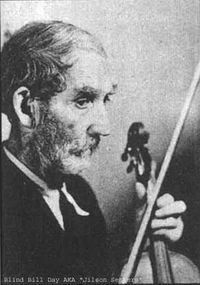Annotation:No Corn on Tygart (2): Difference between revisions
No edit summary |
No edit summary |
||
| Line 5: | Line 5: | ||
<br> | <br> | ||
<br> | <br> | ||
[[File:day.jpg|200px|thumb|left|alt text]] | |||
Day came to attention of folklorist Jean Thomas, who managed his career for a time, producing in him a hillbilly caricature of the 'mountain fiddler'. Even his 'blindness' (he was blind for a time as a young man, but had his sight restored by an operation) was exploited. Day made some recordings in the 1930's and continued to be active at regional folk festivals nearly until he died, in 1942. He even performed at the Royal Albert Hall for the King and Queen of England. | Day came to attention of folklorist Jean Thomas, who managed his career for a time, producing in him a hillbilly caricature of the 'mountain fiddler'. Even his 'blindness' (he was blind for a time as a young man, but had his sight restored by an operation) was exploited. Day made some recordings in the 1930's and continued to be active at regional folk festivals nearly until he died, in 1942. He even performed at the Royal Albert Hall for the King and Queen of England. | ||
<br> | <br> | ||
Revision as of 02:47, 22 July 2014
Back to No Corn on Tygart (2)
NO CORN ON TIGERT/TYGART [2]. AKA and see "Jimmy Ossington," "Snakewinder." Old-Time, Breakdown. USA, Kentucky. G Major. Standard tuning (fiddle). AABB. No relation to "No Corn on Tygart (1)." In Kentucky the tune also goes by the names "Jimmy Ossington" and "Snakewinder" (Buddy Thomas). The tune was recorded in the field for the Library of Congress by collector John Lomax in 1937 from the playing of fiddler James W. Day (1861-1942), who issued some 78 RPM recordings under the pseudonyms 'Jilson Setters' and "Blind Bill" Day. Day was Ed Haley's neighbor and contemporary, and while title "No Corn on Tagart" was a commonality between them, their tunes are completely different (see No Corn on Tagart (1)" for Hayley's version).

Day came to attention of folklorist Jean Thomas, who managed his career for a time, producing in him a hillbilly caricature of the 'mountain fiddler'. Even his 'blindness' (he was blind for a time as a young man, but had his sight restored by an operation) was exploited. Day made some recordings in the 1930's and continued to be active at regional folk festivals nearly until he died, in 1942. He even performed at the Royal Albert Hall for the King and Queen of England.
Source for notated version:
Printed sources:
Recorded sources: Library of Congress 1019B1, Jilson Setters/James W. Day (recorded for John Lomax in Ashland Ky., June, 1937). }.
See also listing at:
Hear the stringband versions by Mossyroof [1], Plankroad [2], and the Cliffhangers [3]
